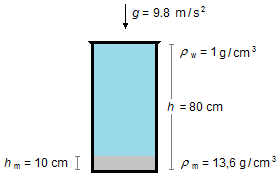Solved Problem on Fluid Mechanics
advertisement
A glass cylinder contains, in the bottom mercury up to 10 cm in height and water to the height of 80 cm, measured from the base. The density of mercury and water are, respectively, 13.6 g/cm3 and 1 g/cm3. Determine the pressure at the bottom of the container.
Problem data:
- Density of mercury: ρm = 13.6 g/cm3;
- Heigh of mercury column: hm = 10 cm;
- Density of water: ρw = 1 g/cm3;
- Height of water column from the base: h = 80 cm;
- Acceleration due to gravity: g = 9.8 m/s2.

Solution
First, we must convert the densities of water and mercury, given in grams per cubic centimeter (g/cm3) to kilograms per cubic meter (kg/m3), and the heights given in centimeters (cm) to meters (m) used in the International System of Units (S.I.)
\[
\begin{align}
\rho_m=13.6\;\mathrm{\frac{\cancel g}{cm^3}}\times\mathrm{\frac{1\;kg}{1000\;\cancel{g}}}\times\mathrm{\frac{(100\;cm)^3}{(1\;m)^3}}=13.6\;\mathrm{\frac{1}{\cancel{cm^3}}}\times\mathrm{\frac{1\;kg}{1\cancel{000}}}\times\mathrm{\frac{1 000 \cancel{000}\;\cancel{cm^3}}{1\;m^3}}
=13600\;\mathrm{\frac{kg}{m^3}}
\end{align}
\]
\[
\begin{gather}
\rho_a=1\;\mathrm{\frac{\cancel g}{cm^3}}\times\mathrm{\frac{1\;kg}{1000\;\cancel{g}}}\times\mathrm{\frac{(100\;cm)^3}{(1\;m)^3}}=1\;\mathrm{\frac{1}{\cancel{cm^3}}}\times\mathrm{\frac{1\;kg}{1\cancel{000}}}\times\mathrm{\frac{1 000 \cancel{000}\;\cancel{cm^3}}{1\;m^3}}
=1000\;\mathrm{\frac{kg}{m^3}}
\end{gather}
\]
\[
\begin{gather}
h_m=10\;\mathrm{\cancel{cm}}\times \mathrm{\frac{1\;m}{100\;\cancel{cm}}}=0,1\;\mathrm m
\end{gather}
\]
\[
\begin{gather}
h=80\;\mathrm{\cancel{cm}}\times \mathrm{\frac{1\;m}{100\;\cancel{cm}}}=0,8\;\mathrm m
\end{gather}
\]
The pressure of a liquid column, pc, is given by
\[
\begin{gather}
\bbox[#99CCFF,10px]
{p_c=\rho gh} \tag{I}
\end{gather}
\]
For mercury pm
\[
\begin{gather}
p_m=\rho_m g h_m\\[5pt]
p_m=\left(13600\;\mathrm{\frac{kg}{m^\cancelto{2}{3}}}\right)\times\left(9.8\;\mathrm{\frac{\cancel m}{s^2}}\right)\times\left(0.1\;\mathrm{\cancel m}\right)\\[5pt]
p_m=13328\;\mathrm{Pa} \tag{II}
\end{gather}
\]
The height of the water,hw, column will be the difference between the measured height
from the base and the height of the mercury column
\[
\begin{gather}
h_w=h-h_m \tag{III}
\end{gather}
\]
Applying the equation (I), we have the pressure of the column of water, pw
\[
\begin{gather}
p_w=\rho_w g h_w \tag{IV}
\end{gather}
\]
substituting equation (III) into equation (IV)
\[
\begin{gather}
p_w=\rho_w g\;(h-h_m)\\[5pt]
p_w=\left(1000\;\mathrm{\frac{kg}{m^\cancelto{2}{3}}}\right)\times\left(9.8\;\mathrm{\frac{\cancel m}{s^2}}\right)\times(0.8\;\mathrm m-0.1\;\mathrm m)\\[5pt]
p_w=\left(9800\;\mathrm{\frac{kg}{m^{\cancel 2}.s^2}}\right)\times(0.7\;\mathrm{\cancel m})\\[5pt]
p_w=6860\;\mathrm{Pa} \tag{V}
\end{gather}
\]
The total pressure on the bottom of the container is given by the sum of the equations (II) and (V)
\[
\begin{gather}
p=p_m+p_w\\[5pt]
p=13328\;\mathrm{Pa}+6860\;\mathrm{Pa}
\end{gather}
\]
\[
\begin{gather}
\bbox[#FFCCCC,10px]
{p=20188\;\mathrm{Pa}}
\end{gather}
\]
advertisement

Fisicaexe - Physics Solved Problems by Elcio Brandani Mondadori is licensed under a Creative Commons Attribution-NonCommercial-ShareAlike 4.0 International License .